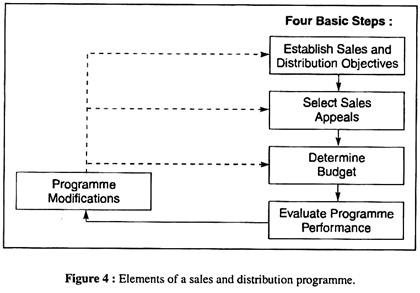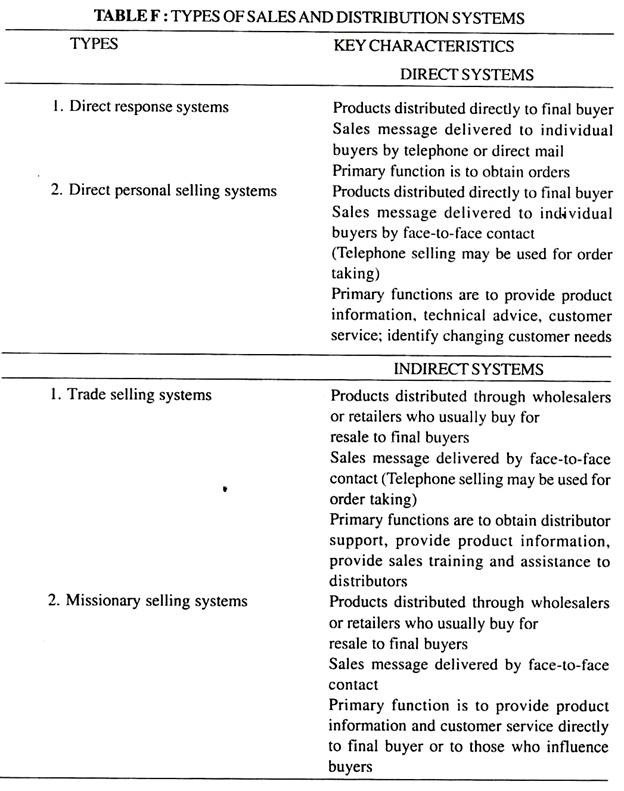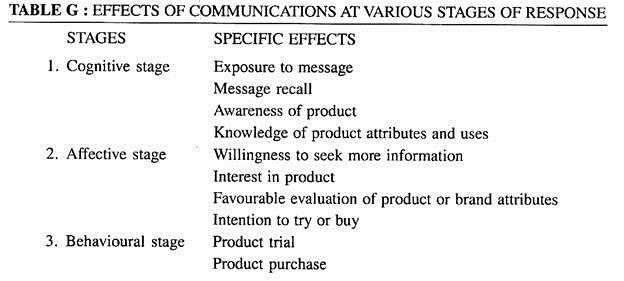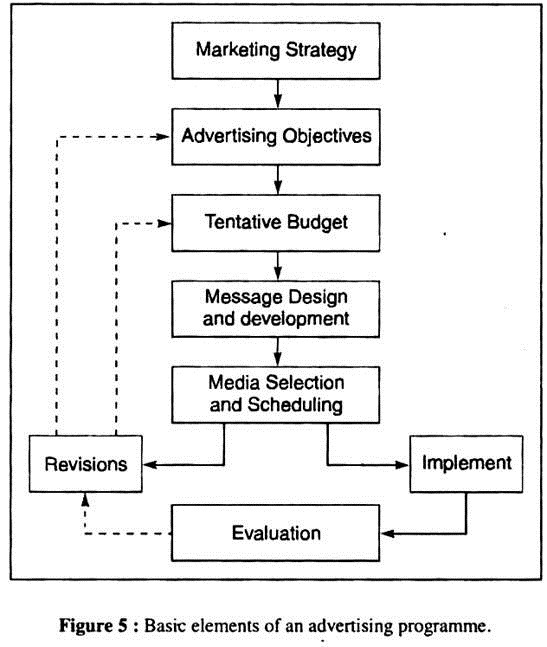In this article we will discuss about:- 1. Sales and Distribution Programme 2. Distribution Channel Structure 3. Vertical Marketing Systems 4. Advertising Programme 5. Types of Advertising Objectives 6. Advertising vs. Promotion.
1. Sales and Distribution Programme:
The main elements of a sales and distribution programme are shown in Figure 4:
As summarised in Table F, marketers can employ four basic types of sales and distribution systems, each of which differs in terms of the role played by personal selling.
2. Distribution Channel Structure:
A distribution channel is a set of organisational units (such as manufacturers, wholesalers, and retailers) that performs all the functions required to get a product from a seller to the final buyer. The structure of the channel is determined by three elements: the tasks and activities to be performed by intermediaries, the type of distributor to be used, and the number of each type of distributor.
Tasks:
Firms engage distributors to perform those marketing tasks that a supplier cannot perform effectively or efficiently. The most widely performed distributor tasks include maintaining availability through local delivery or by having the product at locations convenient to the customer, providing customer financing and maintenance or repair services, and local selling and advertising of the product’s benefits.
These tasks are most likely to be performed by distributors rather than by suppliers when:
1. There are large numbers of buyers, each of whom purchases in small amounts so that the cost of making personal sales calls on each one would be very high if performed by a manufacturer.
2. A detailed knowledge of local market conditions and buyer needs is important because customers vary dramatically in their needs.
3. Special emergency service is important.
4. Competitors provide a high level of availability, and therefore convenience or speed of delivery is necessary to be competitive.
5. Buyers purchase a wide assortment of related products in small volumes while the manufacturer provides only a narrow assortment and thus cannot meet the buyer’s full range of needs.
6. In other words, the tasks that distributors must perform will depend on what is needed to competitively meet customer needs and on the relative economic efficiency of performing or delegating the task.
3. Vertical Marketing Systems:
The increased recognition of the importance of selling through and not just to the distributor had led many firms to develop highly coordinated channels. The term vertical marketing system is generally used to describe types of channels in which distributor actions are very highly coordinated with the manufacturer’s marketing strategy because a strong, continuing, formal relationship has been established.
These systems can be of three types: corporate, contractual, and administered systems.
1. Corporate systems are channels in which some degree of vertical integration takes place. That is, if a retailer is owned by a supplier (or vice-versa) then a corporate system exists. Today, many oil companies, tyre companies, and clothing companies own at least some of their retail outlets.
Although the cost of owning distribution outlets may be great, the sales representatives are generally assured that the distribution outlets will fully support the marketing strategy.
2. Contractual systems include franchising programmes and voluntary associations in which legally binding contracts are established that specify the tasks which each party will perform. Specifically, franchise programmes are contractual arrangements between a manufacturer and a retail or wholesale-level distributor that specify what assistance suppliers will provide a.’ well as the obligations of distributors.
In recent years, these programmes have been dominant in such retail businesses as automobile sales, fast-food restaurants, automotive supplies and courier services, and in some wholesaling businesses (including soft-drink bottling).
These lines of trade are similar in several respects: distributors rely primarily on one supplier, extensive capital investment is required of the distributor, and maintenance of quality service standards is important. Because of these features, suppliers and distributors are highly dependent on each other.
Voluntary associations, on the other hand, are contractual systems organised by wholesalers to provide comprehensive merchandising and promotional programmes to independent retailers. These programmes are primarily designed to assist wholesalers’ customers in maintaining a competitive posture with respect to franchised or vertically integrated chain retailers.
3. Administered systems are channels in which distributors have no contractual or ownership dependency on a supplier. Essentially, these manufacturers provide a wide range of incentives in exchange for extensive promotional support and for carrying large inventories and a full line of products.
4. Advertising Programme:
Probably the most important facets of advertising planning are the development of:
(i) A clear understanding of what the impact of advertising might be on a specific product or service, and
(ii) A clear statement of what the advertising objective should be.
Put another way, advertising programmes should be developed not only in the context of a clear marketing strategy but also in the context of the plans and expectations for the other communications-oriented programmes such as sales promotion, personal selling, publicity, and public relations.
Generally, communications programmes can achieve one or more of the types of effects listed in Table G.
It is important to note that the process of managing the advertising programme can be exceedingly complex because of the number of people who may be involved. Much of the work of advertising is performed by outside organisations (such as advertising agencies). In addition, different kinds of managers are responsible for advertising programmes in different firms.
Figure 5 indicates, there are a number of decisions to be made in managing the advertising programme. Although advertising agencies and other specialists are primarily involved in message design and media decisions, marketing managers in the firm doing the advertising must be somewhat involved in every step of the process.
5. Types of Advertising Objectives:
Although no single typology of advertising objectives is considered to be standard, eight basic types of advertising objectives can be identified.
It is possible to achieve more than one objective during a given campaign, although this can be very difficult and costly. Moreover, each objective is generally most useful for implementing a particular type of marketing strategy.
For instance, for the same product there may be different advertising objectives for different customer groups. Obtaining trial of a particular product or brand may be the objective for nonusers and/or new entrants into the market.
For present users, the objective may be to obtain preference or loyalty for the product or brand. In addition, the promotion objective might be to stimulate demand for the entire product class, for example, electric shavers, and also for a particular brand. Consequently, if more than one objective is employed, it is important to make sure that the various objectives are compatible with the marketing strategy.
The basic types of objectives include:
1. Awareness
2. Reminder to use
3. Changing attitudes about the use of the product form
4. Changing perceptions about the importance of brand attributes
5. Changing beliefs about brands
6. Attitude reinforcement
7. Corporate and product-line image building
8. Obtaining a direct response
6. Advertising Vs. Promotion:
The term promotion is often used to summarise the various activities that are associated with marketing communications.
Promotion strategy has been described as a “controlled, integrated programme of communication methods and materials designed to present an organisation and its products to prospective customers; to communicate need-satisfying attributes of products to facilitate sales and thus contribute to long-run profit performance.”
For management to develop an effective promotional strategy, it is necessary that they have an understanding of the buying process, competition, market segments, and product positioning.
Of the various promotion activities, advertising is clearly the most visible. Indeed, many consumers tend to equate advertising with the term marketing. This is partially explained by the large amount of money spent on advertising by both profit and not-for-profit organisations.



